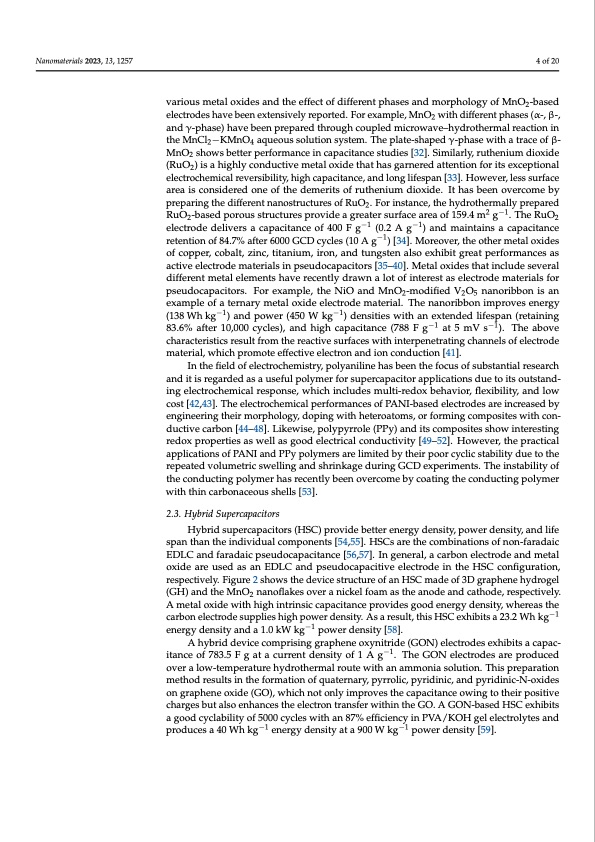PDF Publication Title:
Text from PDF Page: 004
Nanomaterials 2023, 13, 1257 4 of 20 various metal oxides and the effect of different phases and morphology of MnO2-based electrodes have been extensively reported. For example, MnO2 with different phases (α-, β-, and γ-phase) have been prepared through coupled microwave–hydrothermal reaction in the MnCl2−KMnO4 aqueous solution system. The plate-shaped γ-phase with a trace of β- MnO2 shows better performance in capacitance studies [32]. Similarly, ruthenium dioxide (RuO2) is a highly conductive metal oxide that has garnered attention for its exceptional electrochemical reversibility, high capacitance, and long lifespan [33]. However, less surface area is considered one of the demerits of ruthenium dioxide. It has been overcome by preparing the different nanostructures of RuO2. For instance, the hydrothermally prepared RuO2-based porous structures provide a greater surface area of 159.4 m2 g−1. The RuO2 electrode delivers a capacitance of 400 F g−1 (0.2 A g−1) and maintains a capacitance retention of 84.7% after 6000 GCD cycles (10 A g−1) [34]. Moreover, the other metal oxides of copper, cobalt, zinc, titanium, iron, and tungsten also exhibit great performances as active electrode materials in pseudocapacitors [35–40]. Metal oxides that include several different metal elements have recently drawn a lot of interest as electrode materials for pseudocapacitors. For example, the NiO and MnO2-modified V2O5 nanoribbon is an example of a ternary metal oxide electrode material. The nanoribbon improves energy (138 Wh kg−1) and power (450 W kg−1) densities with an extended lifespan (retaining 83.6% after 10,000 cycles), and high capacitance (788 F g−1 at 5 mV s−1). The above characteristics result from the reactive surfaces with interpenetrating channels of electrode material, which promote effective electron and ion conduction [41]. In the field of electrochemistry, polyaniline has been the focus of substantial research and it is regarded as a useful polymer for supercapacitor applications due to its outstand- ing electrochemical response, which includes multi-redox behavior, flexibility, and low cost [42,43]. The electrochemical performances of PANI-based electrodes are increased by engineering their morphology, doping with heteroatoms, or forming composites with con- ductive carbon [44–48]. Likewise, polypyrrole (PPy) and its composites show interesting redox properties as well as good electrical conductivity [49–52]. However, the practical applications of PANI and PPy polymers are limited by their poor cyclic stability due to the repeated volumetric swelling and shrinkage during GCD experiments. The instability of the conducting polymer has recently been overcome by coating the conducting polymer with thin carbonaceous shells [53]. 2.3. Hybrid Supercapacitors Hybrid supercapacitors (HSC) provide better energy density, power density, and life span than the individual components [54,55]. HSCs are the combinations of non-faradaic EDLC and faradaic pseudocapacitance [56,57]. In general, a carbon electrode and metal oxide are used as an EDLC and pseudocapacitive electrode in the HSC configuration, respectively. Figure 2 shows the device structure of an HSC made of 3D graphene hydrogel (GH) and the MnO2 nanoflakes over a nickel foam as the anode and cathode, respectively. A metal oxide with high intrinsic capacitance provides good energy density, whereas the carbon electrode supplies high power density. As a result, this HSC exhibits a 23.2 Wh kg−1 energy density and a 1.0 kW kg−1 power density [58]. A hybrid device comprising graphene oxynitride (GON) electrodes exhibits a capac- itance of 783.5 F g at a current density of 1 A g−1. The GON electrodes are produced over a low-temperature hydrothermal route with an ammonia solution. This preparation method results in the formation of quaternary, pyrrolic, pyridinic, and pyridinic-N-oxides on graphene oxide (GO), which not only improves the capacitance owing to their positive charges but also enhances the electron transfer within the GO. A GON-based HSC exhibits a good cyclability of 5000 cycles with an 87% efficiency in PVA/KOH gel electrolytes and produces a 40 Wh kg−1 energy density at a 900 W kg−1 power density [59].PDF Image | Water-in-Salt Eutectic Solvent-Based Liquid Electrolytes

PDF Search Title:
Water-in-Salt Eutectic Solvent-Based Liquid ElectrolytesOriginal File Name Searched:
nanomaterials-13-01257.pdfDIY PDF Search: Google It | Yahoo | Bing
Salgenx Redox Flow Battery Technology: Power up your energy storage game with Salgenx Salt Water Battery. With its advanced technology, the flow battery provides reliable, scalable, and sustainable energy storage for utility-scale projects. Upgrade to a Salgenx flow battery today and take control of your energy future.
CONTACT TEL: 608-238-6001 Email: greg@infinityturbine.com (Standard Web Page)